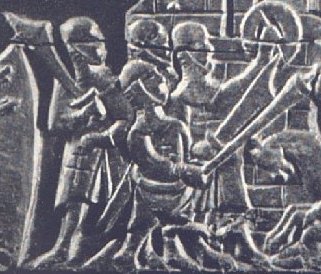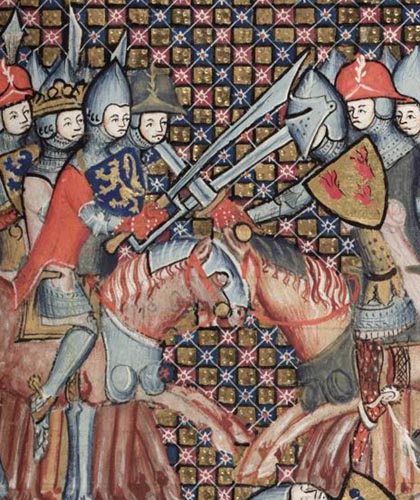The one in the photo below may be sharpened on the long edge (there is evidence of greater corrosion there) but the fuller along that same edge seems unusual.
Does anyone have any information on this type of sword?






| D. Austin wrote: |
| The one in the photo below may be sharpened on the long edge (there is evidence of greater corrosion there) but the fuller along that same edge seems unusual.
|
| Chad Arnow wrote: |
| MRL's version of one of these has been discussed here: http://www.myArmoury.com/talk/viewtopic.php?t=10099
This style of sword has also been discussed here: http://www.myArmoury.com/talk/viewtopic.php?t=8806 |
| Dan Dickinson wrote: |
|
Tinker also make a recreation of this type of blade....and if I remember correctly was quite effective. http://forums.swordforum.com/showthread.php?t...ion+tinker |
| D. Austin wrote: |
| I guess that from this information, we can conclude that these weapons, although looking remarkably like a backwards falchion, would be used in a different style |
| D. Austin wrote: |
| I guess that from this information, we can conclude that these weapons, although looking remarkably like a backwards falchion, would be used in a different style |
| Bill Grandy wrote: |
| I wouldn't go that far. There are only so many ways to use a sword... consider that the messerfechten of Hans Leckuchner and the longsword of Johannes Liechtenauer is remarkably similar, almost identical in some places, even though the messer and longsword would appear to be fairly different weapons, superficially. If I had a reverse edged falchion, I would see no reason to use it any differently than a more typical falchion. |
| D. Austin wrote: |
| Without wishing to claim any knowledge of the use of a falchion, I guess I would just assume that a convex edge wold be better for slicing or for a 'pulling' cut, than a concave one. |
| Bill Grandy wrote: |
|
As for the name "chopper", I have to say, I really hate that term. It implies that these weapons must have somehow been brutish, requiring little skill. Now, I've never handled one for real, so I wouldn't know one way or another... but consider how many myths there are about falchions and messers being heavy, slow, and used for chopping through plate armour, and consider the reality. Those myths came about because people saw pictures and made assumptions about their usage without actually ever holding one, so much so that even many sword enthusiasts who will claim a longsword is light will sometimes also say that a falchion was awkward and heavy. But that's just my pet peeve. :) |
| Anders Backlund wrote: |
| [
Correct me if I'm wrong -English not being my first language- but doesn't the word "chop" simply describe a particular type of cut or motion, same as "slice" or "slash"? To me it simply implies a weapon made to deal a certain kind of damage using a certain technique. I don't see how using a fighting style based on heavy cutting blows suggests a lack of technique, however. In fact, if I used a weapon based around heavy chopping I'd want to be pretty damn skilled with it. |
| Jean Thibodeau wrote: |
| A chop is something one can do with a sword but think of the way one uses an axe: A chop has no slicing component and cuts as a sharp wedge hitting at 90 degrees to the object cut. ( At least mostly 90 degrees but with cutting logs one will tilt the axe on alternating sides to cut a wedge of the wood out of the log or tree ).
A slice is a pulling or pushing of the edge with more or less pressure. With a sword there can be a combination of chopping along with a slice or draw cut to varying degrees from an almost pure chop to almost no pressure but a fast slice. Curved edged swords create a slicing component so that almost any chop will also slice with minimal effort. ( With very curved swords one would have to work hard to do a chop without some slicing motion at the end of the stroke at least ). |